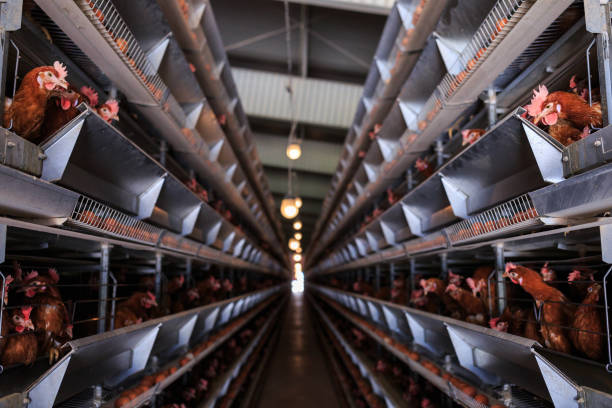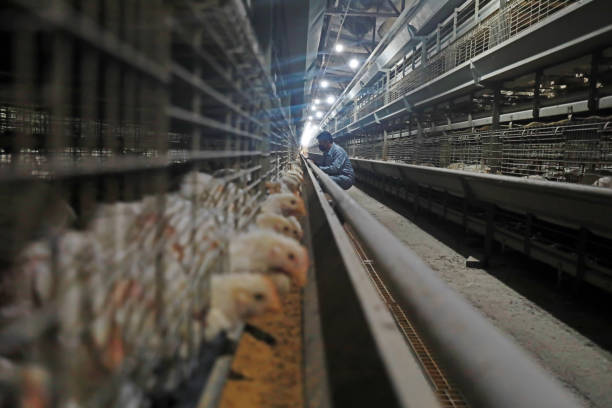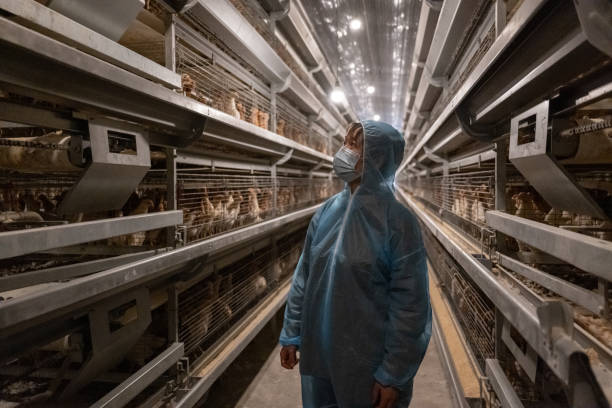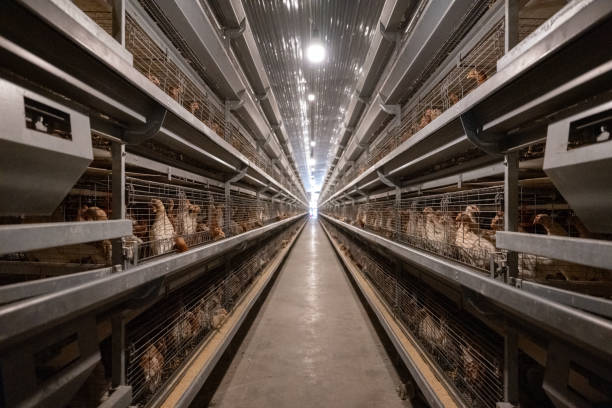
Efficient 10000 Layer Poultry Farming System
Efficient 10000 Layer Poultry Farming System
Running a large-scale poultry farm with 10,000 laying hens is no small task, but with the right system in place, it can become a highly productive, profitable, and sustainable operation. At Livi Machinery, we’ve designed and installed hundreds of 10,000-layer poultry farming systems across Asia, Africa, and South America—and one thing is clear: efficiency starts with smart design. A well-planned system not only maximizes egg production and bird health but also minimizes labor, feed waste, and disease risk. In this article, we’ll walk you through what makes a 10,000-layer farm truly efficient, from housing layout to automation and day-to-day management best practices.
Smart Layout and Space Utilization

One of the most critical factors in building an efficient 10,000-layer poultry farming system is how you use your space. Simply cramming birds into a long shed won’t cut it—it leads to stress, poor ventilation, and uneven temperature distribution, all of which lower egg output and invite disease. Instead, an optimal layout divides the flock across multiple rows of tiered cages, allowing for better airflow, easier monitoring, and consistent feeding and watering.
For a 10,000-bird setup, we typically recommend a barn size between 900–1,200 square meters depending on local climate and cage density. Using a three-tier A-frame cage system allows you to house the birds efficiently while still maintaining comfortable headroom and access for workers. Each tier should have individual feeding lines, water lines, and manure belts. This design prevents cross-contamination and ensures every bird gets equal access to food and water.

Ventilation is another key element. Our clients often underestimate how vital air quality is—especially in tropical regions. That’s why we integrate natural cross-ventilation with tunnel fans and evaporative cooling pads. This combination keeps temperatures stable (ideally between 18°C and 25°C), reduces ammonia buildup, and keeps the birds stress-free during peak summer months. Good airflow doesn’t just keep chickens healthy—it directly influences egg production and shell quality.
Automation That Pays for Itself
Let’s talk about automation—this is where a modern 10,000-layer poultry farming system really shines. While manual operations might work for smaller farms, anything above 5,000 birds quickly becomes unmanageable without automated support. Think about it: collecting eggs twice a day by hand from 10,000 hens takes hours, increases breakage, and raises labor costs. But with an automatic egg collection system, those same eggs are gently rolled onto belts and delivered straight to a central packing station in minutes.
We equip our systems with fully integrated automation packages including:
Automatic feeding: Timed auger systems distribute feed evenly across all cages without overfeeding or underfeeding.
Nipple drinking lines: These reduce water spillage and prevent bacterial growth—critical for maintaining gut health.
Manure removal belts: Running 1–2 times daily, they keep the house dry and hygienic, reducing flies and respiratory issues.
Centralized control panels: Farmers can monitor temperature, humidity, fan speed, and even lighting schedules from a smartphone or tablet.
Don’t assume automation is expensive and hard to maintain. Our systems are built with durability in mind—galvanized steel frames, UV-resistant plastic components, and wear-resistant motors mean less downtime and longer service life. Many of our customers recover their initial investment in under two years thanks to lower labor bills and improved feed conversion ratios (FCR). When birds are fed precisely and live in a stress-free environment, they eat better, grow stronger, and lay more consistently.
Health, Hygiene, and Long-Term Success
Even the most advanced equipment won’t deliver results if biosecurity and hygiene are neglected. A single outbreak of Newcastle disease or avian flu can wipe out profits overnight. That’s why we train every client on strict farm protocols before commissioning a new 10,000-layer system.
Start with controlled access: install footbaths at entry points, provide changing rooms for staff, and limit visitor access. Routine disinfection of cages, tools, and equipment is non-negotiable. We also recommend scheduling regular blood testing and collaborating with a local vet to stay ahead of potential issues.
Nutrition plays a huge role too. While some farmers try to save money with low-quality feed, that approach backfires fast. Poor nutrition leads to soft-shelled eggs, weak birds, and higher mortality. Work with a trusted feed supplier to ensure your layers get balanced rations rich in calcium, protein, and essential vitamins. During peak laying periods (weeks 25–75), even minor deficiencies can cost thousands in lost revenue.
Lighting strategy is another often-overlooked detail. Hens need about 14–16 hours of light per day to maintain high egg production. Use energy-efficient LED lights on timers to simulate sunrise and sunset gradually—abrupt changes stress birds and cause sudden drops in laying rates. Our systems come with programmable lighting controllers that adjust intensity and duration based on flock age.
Finally, don’t forget record keeping. Track daily egg counts, feed consumption, water intake, mortality, and vaccination dates. Data-driven decisions help you spot trends early—whether it’s a drop in FCR or rising water usage—which could signal underlying problems before they escalate.
Ready to Build Your Own Efficient 10,000-Layer Farm?
If you’re planning a commercial layer project or upgrading an existing facility, now is the perfect time to invest in a smart, scalable solution. At Livi Machinery, we’ve helped farmers in over 30 countries build profitable, future-ready poultry operations—from site assessment and engineering design to installation and training. Whether you’re setting up in a hot desert region or a humid coastal area, we tailor each system to your specific needs.

Our turnkey solutions include everything: high-quality cages, feeder/water systems, incubators, brooders, manure conveyors, and climate control units—all backed by after-sales support and technical guidance. We speak your language, understand local market demands, and offer flexible shipping options to get your farm running faster.
So what’s next? Tell us about your project. Share your location, available space, target capacity, and any special requirements. One of our experts will reply within 24 hours with a customized proposal and 3D layout. Let’s make your dream of a high-efficiency 10,000-layer poultry farm a reality.
Contact us today—we’d love to hear from you.
Frequently Asked Questions
What does a complete 10,000-layer poultry farming system include?
Everything from cages and feeders to drinkers, egg collection belts, manure removal systems, and environmental controls. Optional add-ons include automatic sorting tables, weighing systems, and solar-powered setups.
How much does it cost to set up a 10,000-layer farm?
Total investment varies based on automation level and location, but typically ranges from $60,000 to $100,000 USD. This includes equipment, shipping, and installation support.
Can the system be expanded later?
Yes. Our modular cage designs allow you to add more rows or even build a second shed using the same control infrastructure.
Is training provided after installation?
Absolutely. We offer on-site or remote training for your team covering operation, maintenance, troubleshooting, and daily management routines.
How long do the cages last?
Our galvanized steel cages are corrosion-resistant and built to last 15+ years under normal conditions. Many customers report still using their original systems after more than a decade.
Do you help with farm design and layout planning?
Yes. Our engineers provide free site evaluation and 3D layout drawings tailored to your building dimensions and local climate.
What kind of electricity does the system need?
Most systems run on standard single-phase or three-phase power (220V/380V). We can customize electrical components for different grid standards worldwide.
How many workers are needed to manage 10,000 layers?
With full automation, just 2–3 trained staff can manage daily operations smoothly, including feeding, egg collection, and cleaning.
Are spare parts available locally?
We ship spare kits with every order and maintain global inventory. Common parts like motors, sensors, and nipples are easy to replace and widely compatible.
Can I see a working farm using your system?
Definitely. We can connect you with current clients who’ve agreed to share their experience—or arrange a live video tour of an operational site.
